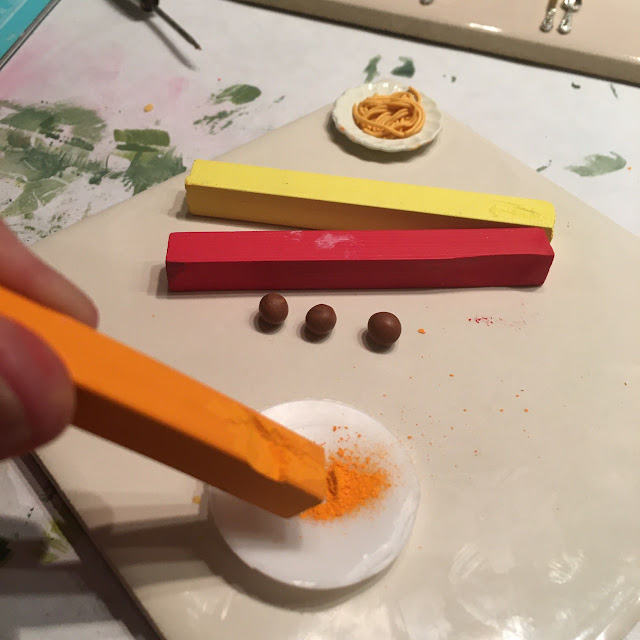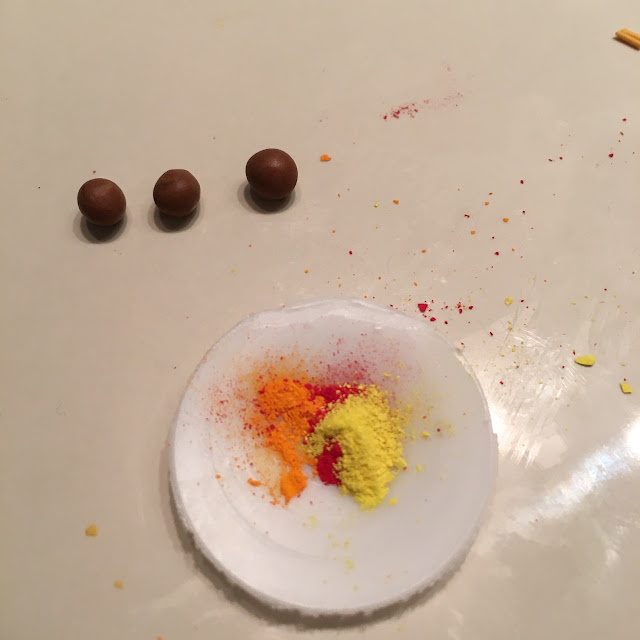 A couple of years ago I purchased 3 vintage dollhouses from a a local antique store. Then I had buyer's remorse, wondering what I was going to do with those three aged houses. You've seen one, the Storybook that I renovated into a toy store. I had decided, actually, to leave the houses as they were, honoring the original builder, her talent, her hard work, and her love for the art of miniatures. I never met the woman; I only know what the antique deal told me: an elderly woman who had a dozen houses that her daughters were making her sell because they were sending her to assisted living. I can only imagine how she must have felt giving up her houses. So I own four of her houses, fully furnished and a general store. One of the houses is the half scale Fairfield, a Green Leaf Dollhouse that was probably the first edition made in the '80s, maybe. This 1:24 scale house is a great beginner house that sells for under $100.00. As I search for inspirations, I am discovering that there are two versions, mine must be the older one. It has two exterior doors, one to the kitchen and one the front entry. The stairs in the house are hidden behind the living room wall, making the entry very hard to access.
A couple of years ago I purchased 3 vintage dollhouses from a a local antique store. Then I had buyer's remorse, wondering what I was going to do with those three aged houses. You've seen one, the Storybook that I renovated into a toy store. I had decided, actually, to leave the houses as they were, honoring the original builder, her talent, her hard work, and her love for the art of miniatures. I never met the woman; I only know what the antique deal told me: an elderly woman who had a dozen houses that her daughters were making her sell because they were sending her to assisted living. I can only imagine how she must have felt giving up her houses. So I own four of her houses, fully furnished and a general store. One of the houses is the half scale Fairfield, a Green Leaf Dollhouse that was probably the first edition made in the '80s, maybe. This 1:24 scale house is a great beginner house that sells for under $100.00. As I search for inspirations, I am discovering that there are two versions, mine must be the older one. It has two exterior doors, one to the kitchen and one the front entry. The stairs in the house are hidden behind the living room wall, making the entry very hard to access. The house came with all of its furniture with a few accessories.
It's a charming house, but shows the years. While it is in very good condition, it is dirty with layers of dust that dulls the luster and the colors.
While the builder's workmanship was sound she did have problems in the kitchen, which is probably what prompted me to do something. The rest of house still looks pretty, but. . .
. . .the kitchen is just awful.
I've been contemplating buying another large house-- the new house that Real Good Toys offers, but I'm running out of room and I already have three big farmhouses, and the not so small Brockwood, so I decided to start a renovations project, prompted, as I said, by this very sad kitchen.
Red upholstery is not my favorite. My mother, though, would have loved the red Victorian dining set and the red sitting room.
I am still pondering if I should use the original furniture or buy kits to make new. I've been doing a lot of research looking to see how this little house is decorated.
Blue is nice, but age has soiled the surfaces.
So, the other night, I tested the waters to see if I could removed the awful "metal" which turned out to be plastic ceiling liner on the roof pieces. It actually came off very easily
This is where I began, removing the the faux tin roof on the porch, but I didn't stop there.
Once I tested the living room wallpaper to see how easily it might come off there was not turning back. I used my Cricut paddle to remove the wallpaper. Worked great.
Then I ripped up the some carpet.
Next I tested some woodwork. The wood trim actually removed very easily. First I had to find the spot where the glue had not been so heavily applied. I did discover that the glue was the most firm at the bottom of the pieces. Once I got a spot loose the rest came free easily. I am guessing that the glue had dried with age and lost some of its grip, for all of the door trim and interior window released easily. These wooden pieces were also glue to the wall paper not wood to wood, which I think, helped release the bond. I was able to remove all the interior wood trims without breaking any of them.
The carpet was much more difficult to remove, leaving carpet clinging to globs of glue.
Before I knew it, I twas on my way to a full blown renovation project. There was no turning back. The wall paper practically slid off the wall once I saturated it with fabric softener mixed with hot water in a small spray bottle. It even dissolved the glue that held the carpet in place after taking several minutes to dissolve the glue enough to scrape it away.
This wall is probably the worst one in the house, but fabric softener really does eat through the glue used on this house.
Removing the paper kitchen flooring was more challenging. I've stripped enough wallpaper over the years in my homes that I knew to score the flooring to help the fabric softer penetrate the paper.
Finally after a lot of scrapping, the kitchen is clean.
The third level still needs to be stripped and I have to decided how to deal with the entry way at the front door and the second story hallway, both fairly inaccessible. I might be able to wallpaper over the current paper, but I'm not sure that I can get hand in the small area.
But I wasn't done. I decided to try to remove the front porch railing so that I can update it with new, more decorative railing. I sprayed the joints with fabric softener and with gently prying the glue popped free.
I am trying to decide if I want to replace the doors. Upgrade them, you know. I am even considering closing off the door that goes into the kitchen because it ruins the layout of the kitchen floor plan. The second edition of the Fairfield doesn't have the kitchen door, which makes for a better kitchen floor plan. I did remove the front door and broke the the door jamb in the process, so yes, there will be a new front door.
But I didn't break the porch apart then I removed it.
I am getting very excited bring new life to this great little house.
And look what arrived Saturday. With encouragement from Sherrill and Jodi, I took the big step in miniature making and added new tool to my workroom: the Circuit Maker. And what an impressive machine it is.
I waited long enough that the price came down another $40, but there were only two colors available. I chose to match my phone rather than the wall. Actually, what's in a color?
Unboxing the machine is an experience. I mean, an elegant one with the documents sealed in classy black envelopes; chic cue cards to direct the set up. The machine comes with the scoring wheel and deep cut blade, a piece of fabric and card to make your first cut.
Also packaged with machine are two mats. I purchased one with the accessory kit and received three more cutting mats.
Set-up was so easy. In minutes I made my first project.
I may be making new cabinets for the Fairfield, so designed a box in Cricut's Design Space. I am so pleased with the machine. It will be amazing. I'm not new to Cricut; I've had an Expression II for years, but this one takes shape cutting to a whole new level.
Thank you, ladies for patiently taking the time to answer my questions.
Well, that was a lot. Thanks for stopping by. I'll be back with more on the Fairfield. I think I'll paint the exterior next. What color? I don't know, yet. See you soon.
























































































